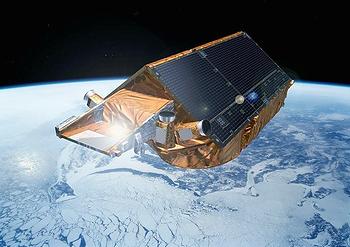
LEEDS, England, UK, May 16, 2019 (ENS) – The warming of ocean waters over the 25 years between 1992 and 2017 have caused the glacier ice in West Antarctica to thin so rapidly that 24 percent of the region’s ancient ice is now affected, a British research team has determined.
“We can see clearly now that a wave of thinning has spread rapidly across some of Antarctica’s most vulnerable glaciers, and their losses are driving up sea levels around the planet,” said Dr. Andrew Shepherd, director of the UK Centre for Polar Observation and Modelling, CPOM, at Leeds University.

“Parts of Antarctica have thinned by extraordinary amounts,” Shepherd said. “So we set out to show how much was down to changes in climate and how much was instead due to weather.”
By combining 25 years of data gathered by European Space Agency satellites, the CPOM scientists found that the ice sheet has thinned by up to 122 metres (400 feet) in places, with the most rapid changes occurring in West Antarctica where ocean melting has triggered glacier imbalance.
“After 25 years, the pattern of glacier thinning has spread across a quarter of West Antarctica, and its largest ice streams – the Pine Island and Thwaites Glaciers – are now losing ice five times faster than they were in the 1990s,” Shepherd stressed.
“Altogether, ice losses from East and West Antarctica have added 4.6 millimeters (0.177 inches) of water to global sea level since 1992,” he said.
Published in the journal “Geophysical Research Letters,” his latest paper on this subject describes how the researcher team used over 800 million measurements of Antarctic ice sheet height recorded by radar altimeter instruments on ESA’s ERS-1, ERS-2, Envisat and CryoSat satellite missions between 1992 and 2017.
Shepherd and colleagues have been watching these same glaciers thin for decades. In 2004, another Shepherd paper in “Geophysical Research Letters,” stated, “Satellite radar measurements show that ice shelves in Pine Island Bay have thinned by up to 5.5 m yr−1 over the past decade. The pattern of shelf thinning mirrors that of their grounded tributaries ‐ the Pine Island, Thwaites and Smith glaciers ‐ and ocean currents on average 0.5°C warmer than freezing appear to be the source.”

Shepherd and his co-authors concluded back in 2004 that, “Antarctica is more sensitive to changing climates than was previously considered.”
The most recent CPOM study also used simulations of snowfall over the same period produced by the RACMO regional climate model.
Together, these measurements allow changes in ice-sheet height to be separated into those that impact snow, and those that impact ice. Meteorological events affect snow, and events caused by longer-term changes in climate affect ice.
To determine this, the research team compared measurements of surface-height change with the simulated changes in snowfall. Where the signal was greater they attributed its origin to glacier imbalance.
They found that fluctuations in snowfall tend to drive small changes in height over large areas for a few years at a time, whereas the most pronounced changes in ice thickness coincide with signals of glacier imbalance that have persisted for decades.
Professor Shepherd explained, “Knowing how much snow has fallen has really helped us to isolate the glacier imbalance within the satellite record.”
Now that Cryosat is operating past the end of its scheduled lifetime, another satellite, Sentinel-3 – one of the EU Copernicus satellite missions – is being utilized to take measurements that contribute towards long-term ice sheet monitoring programs.
From its orbit 815 kilometers (506 miles) above the Earth, Sentinel-3 can detect the height of the ice surface at the remote Lake Vostok test site in East Antarctica to within tens of centimeters.
The scientists also found that Sentinel-3 could detect where the ice surface was rapidly lowering, establishing the satellite’s credentials as a new platform that monitor Antarctica’s contribution to sea level rise.
Marcus Engdahl, a satellite image processing and mapping specialist with the European Space Agency, said, “This is a fantastic demonstration of how satellite missions can help us to understand how our planet is changing. The polar regions are hostile environments and are extremely difficult to access from the ground. Because of this, the view from space is an essential tool for tracking the effects of climate change.”
“Scientific results such as this are key to understanding how our planet works and how natural processes are being affected by climate change – and ice is a hot topic at ESA’s Living Planet Symposium, which is currently in full swing in Milan,” said Engdahl. “This study demonstrates that the changing climate is causing real changes in the far reaches of the Antarctic.”
Copyright Environment News Service (ENS) 2019. All rights reserved.
© 2019, Environment News Service. All rights reserved. Content may be quoted only with proper attribution and a direct link to the original article. Full reproduction is prohibited.
